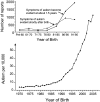The role of oxidative stress, inflammation and acetaminophen exposure from birth to early childhood in the induction of autism
- PMID: 28415925
- PMCID: PMC5536672
- DOI: 10.1177/0300060517693423
The role of oxidative stress, inflammation and acetaminophen exposure from birth to early childhood in the induction of autism
Abstract
The wide range of factors associated with the induction of autism is invariably linked with either inflammation or oxidative stress, and sometimes both. The use of acetaminophen in babies and young children may be much more strongly associated with autism than its use during pregnancy, perhaps because of well-known deficiencies in the metabolic breakdown of pharmaceuticals during early development. Thus, one explanation for the increased prevalence of autism is that increased exposure to acetaminophen, exacerbated by inflammation and oxidative stress, is neurotoxic in babies and small children. This view mandates extreme urgency in probing the long-term effects of acetaminophen use in babies and the possibility that many cases of infantile autism may actually be induced by acetaminophen exposure shortly after birth.
Keywords: Autism; acetaminophen; inflammation; oxidative stress; paracetamol; paracetamolo.
Figures



References
-
- Tanne JH. Maternal obesity and diabetes are linked to children’s autism and similar disorders. BMJ 2012; 344: e2768–e2768. - PubMed
-
- Parker W, Perkins SE, Harker M, et al. A prescription for clinical immunology: the pills are available and ready for testing. Curr Med Res Opin 2012; 28: 1193–1202. - PubMed
-
- Brenner SL, Jones JP, Rutanen-Whaley RH, et al. Evolutionary mismatch and chronic psychological stress. J Evol Med 2015; 3: 235885–235885.
Publication types
MeSH terms
Substances
LinkOut - more resources
Full Text Sources
Other Literature Sources

